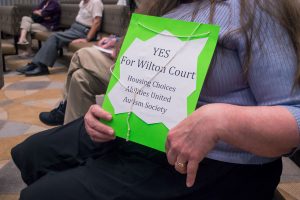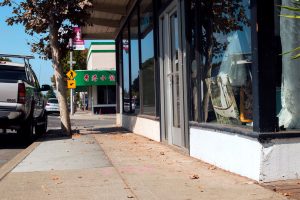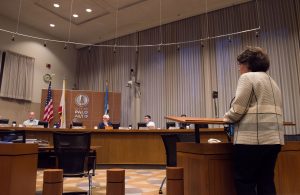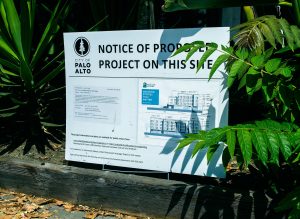Residents of Palo Alto’s Ventura neighborhood say a new affordable housing project under consideration by the city will cause parking problems and traffic congestion and are negotiating with the developer to scale it back.
Wilton Court — a 100 percent affordable housing project on the corner of Wilton Avenue and El Camino Real — could be the first project of its kind to be approved by the city since 2009. The developer is Palo Alto Housing, a nonprofit that operates throughout the Bay Area.
Palo Alto’s Architectural Review Board is reviewing the design of the project. If they approve it, the city council could vote for final approval before the year’s end.

The project would have 59 units – 58 studios and one one-bedroom — and 41 parking spaces. A quarter of the units would be reserved for adults with developmental disabilities.
Wilton Court is located in the Ventura neighborhood is an area that is a bit less pricey and a little less densely built than other parts of Palo Alto. The city is reviewing six major development projects there including Wilton Court.
But the current residents of Ventura have been protesting the developments – a mix of housing and offices — at city meetings, arguing their quiet neighborhood is changing for the worse.
Because of development, there’s more traffic in the streets, they say, and new residents with cars could further reduce parking availability. Residents say there are so many cars parked on the streets that they make exiting driveways dangerous. In the last month, two girls on bikes were injured in the neighborhood.
Resident Gary Mahany says he talked to the city council about placing bollards at the El Camino entry of Wilton Avenue to stop traffic from entering the neighborhood. “But no one’s really committed to it,” he said in an interview. “They just clap you on the back and say it’s a great idea.”
Councilman Adrian Fine said in an email that the city always evaluates traffic impacts and resident’s suggestions to solve them. But “While a simple solution may sound appealing, it may be completely inappropriate or counterproductive,” he said.

To mitigate the issues, Venturans want Palo Alto Housing to reduce the number of units in the Wilton Court project and create more parking spaces to reduce spillover parking in the streets.
Resident Becky Sanders said the amount of traffic coming through the neighborhood has severely increased in recent years. She dismissed any suggestion that residents’ concerns were motivated by not wanting an affordable housing complex in the neighborhood.
“I want to see Wilton Court built,” she said. “But I don’t think it can be built in a vacuum. And I think it’s not fair of the city to say: ‘Oh Ventura, let’s just put it over there’.”
Palo Alto’s housing shortage is severe. The city is behind on its plan to create 300 new housing units annually. According to Palo Alto Weekly, the city approved 57 units this year and will lose 75 units when it shuts the President Hotel apartment complex.
City Hall approved a zoning overlay earlier this year to make affordable housing more attractive for developers. The overlay allows flexible building requirements for affordable housing projects – such as increasing the maximum building size and height limit and reducing parking space requirements — in an area along El Camino where stable public transit is half a mile away.

The city defines affordable housing as homes for people earning up to 120 percent of the Area Median Income (AMI). In Palo Alto, the AMI for a single person is $87,650 annually. But a developer can set a lower income level for eligibility. Wilton Court will only be available to those earning up to 60 percent of the AMI.
According to Ed Lauing, chair of the Planning and Transportation Commission, City Hall should focus its efforts on building housing for people earning below 80 percent of the AMI, because the need is greatest there.
For him, another problem with the overlay is that his commission can only decide if a project complies with the zoning standards. It cannot take into account whether projects are situated in an area that is already crowded with development.
Venturans feel this is the case in their neighborhood. The new zoning area covers part of Ventura, along with much of South Palo Alto. Most affordable housing developments in the new zone will be built close to Venturans’ homes.
“I was furious they just rezoned most of South Palo Alto to accommodate their housing projects,” said Sanders. “The city created the job-housing imbalance, not the residents. If we’re all being asked to solve it, must only a few people be asked, must only the poorest people?”

Councilman Adrian Fine says the city is not targeting certain neighborhoods with the zoning overlay. He says it’s important to incentivize affordable housing. “We haven’t approved an affordable housing project in years. Without this overlay, Wilton Court would not be possible,” he said.
At the monthly Ventura Neighborhood Association meeting on Oct. 7, about 15 community members gathered to talk about Wilton Court and negotiate with Palo Alto Housing to scale back the project.
Many said they wanted to support it, but felt that City Hall was dumping development in their neighborhood without consulting their needs.
“I fear that if we come down too hard on this, it might be replaced by something worse. And then we’re all worse off,” said resident Susan Kemp.
Sheryl Klein, board chair of Palo Alto Housing and in charge of Wilton Court, said she considered taking down a story of the building to address residents’ concerns. Housing projects like these usually cost around $30 million, and significantly reducing the number of units might not be economically feasible.
“We want to build as much as we can, but we also want to be a good neighbor,” she said.
Legend
Green: Affordable Housing Zoning Overlay
Blue: Unsuitable for overlay
Red: Exempt from inclusion
